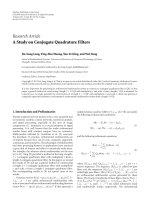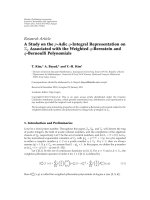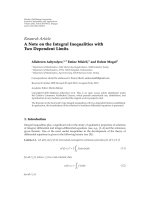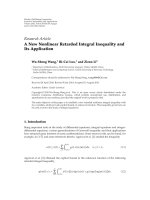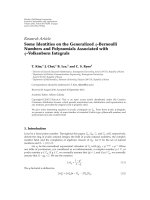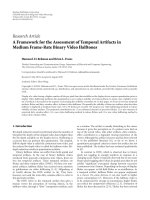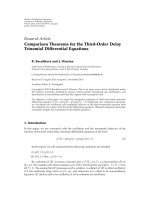Báo cáo hóa học: " Research Article A Note on the Integral Inequalities with Two Dependent Limits" ppt
Bạn đang xem bản rút gọn của tài liệu. Xem và tải ngay bản đầy đủ của tài liệu tại đây (511.19 KB, 18 trang )
Hindawi Publishing Corporation
Journal of Inequalities and Applications
Volume 2010, Article ID 430512, 18 pages
doi:10.1155/2010/430512
Research Article
A Note on the Integral Inequalities with
Two Dependent Limits
Allaberen Ashyralyev,
1, 2
Emine Misirli,
3
and Ozlem Mogol
3
1
Department of Mathematics, Fatih University, Buyukcekmece, 34500 Istanbul, Turkey
2
Department of Mathematics, ITTU, 74200 Ashgabat, Turkmenistan
3
Department of Mathematics, Ege University, 35100 Bornova-Izmir, Turkey
Correspondence should be addressed to Emine Misirli,
Received 4 October 2009; Revised 28 April 2010; Accepted 5 July 2010
Academic Editor: Martin Bohner
Copyright q 2010 Allaberen Ashyralyev et al. This is an open access article distributed under
the Creative Commons Attribution License, which permits unrestricted use, distribution, and
reproduction in any medium, provided the original work is properly cited.
The theorem on the Gronwall’s type integral inequalities with two dependent limits is established.
In application, the boundedness of the solutions of nonlinear differential equations is presented.
1. Introduction
Integral inequalities play a significant role in the study of qualitative properties of solutions
of integral, differential and integro-differential equations see, e.g., 1–4 and the references
given therein. One of the most useful inequalities in the development of the theory of
differential equations is given in the following lemma see 5.
Lemma 1.1. Let ut and ft be real-valued nonnegative continuous functions for all t ≥ 0.If
u
2
t
≤ c
2
2
t
0
f
s
u
s
ds
1.1
for all t ≥ 0,wherec ≥ 0 is a real constant, then
u
t
≤ c
t
0
f
s
ds
1.2
for all t ≥ 0.
2 Journal of Inequalities and Applications
Note that the generalization of this integral inequality and its discrete analogies are
given in papers 5–8. In paper 9 the following useful inequality with two dependent limits
was established.
Lemma 1.2. Let ut be a real-valued nonnegative continuous function defined on −T, T and let c
and a be nonnegative constants. Then the inequality
u
t
≤ c sgn
t
t
−t
au
s
ds, −T ≤ t ≤ T
1.3
implies that
u
t
≤ ce
2a|t|
, −T ≤ t ≤ T.
1.4
The theory of integral inequalities with several dependent limits and its applications
to differential equations has been investigated in 10–14.
The present study involves some Gronwall’s type integral inequalities with two
dependent limits. Section 2 includes some new integral inequalities with two dependent lim-
its and relevant proofs. Subsequently, Section 3 includes an application on the boundedness
of the solutions of nonlinear differential equations.
2. A Main Statement
Our main statement is given by the following theorem.
Theorem 2.1. Let ut, at, bt, gt, ht, and mt be real-valued nonnegative continuous
functions defined on R −∞, ∞.
(i) Let c be a nonnegative constant. If
u
2
t
≤ c
2
2sgn
t
t
−t
m
s
u
s
ds
2.1
for t ∈ R, then
u
t
≤ c sgn
t
t
−t
m
s
ds
2.2
for all t ∈ R.
(ii) Let p>1 be a real constant. If
u
p
t
≤ a
t
b
t
sgn
t
t
−t
g
s
u
p
s
h
s
u
s
ds
2.3
Journal of Inequalities and Applications 3
for t ∈ R, then
u
t
≤
a
t
b
t
exp
sgn
t
t
−t
b
r
g
r
1
p
h
r
dr
× sgn
t
t
−t
a
s
g
s
1
p
h
s
p − 1
p
h
s
×exp
−sgn
s
s
−s
b
r
g
r
1
p
h
r
dr
ds
1/p
2.4
for all t ∈ R.
(iii) Let ct be a real-valued positive continuous and nondecreasing function defined on R and
p>1 be a real constant. If
u
p
t
≤ c
p
t
b
t
sgn
t
t
−t
g
s
u
p
s
h
s
u
s
ds
2.5
for t ∈ R, then
u
t
≤ c
t
1 b
t
exp
sgn
t
t
−t
b
r
g
r
h
r
c
1−p
r
p
dr
× sgn
t
t
−t
g
s
h
s
c
1−p
s
×exp
−sgn
s
s
−s
b
r
g
r
h
r
c
1−p
r
p
dr
ds
1/p
2.6
for all t ∈ R.
(iv) Let kt, s and its partial derivative ∂kt, s/∂t be real-valued nonnegative continuous
functions on −∞ <s≤ t<∞ and let kt, s be even function in t. If
u
p
t
≤ a
t
b
t
sgn
t
t
−t
k
t, s
g
s
u
p
s
h
s
u
s
ds
2.7
for t ∈ R, then
u
t
≤
a
t
b
t
exp
sgn
t
t
−t
k
r, r
b
r
g
r
1
p
h
r
dr
×
sgn
t
t
0
sgn
s
s
−s
∂
∂s
k
s, r
a
r
g
r
1
p
h
r
p − 1
p
h
r
dr
× exp
−sgn
s
s
−s
k
r, r
b
r
g
r
1
p
h
r
dr
4 Journal of Inequalities and Applications
× exp
sgn
t
t
s
sgn
r
r
−r
∂
∂r
k
r, y
b
y
g
y
1
p
h
y
dy dr
ds
sgn
t
t
−t
k
s, s
exp
−sgn
s
s
−s
k
r, r
b
r
g
r
1
p
h
r
dr
×
a
s
g
s
1
p
h
s
p − 1
p
h
s
B
k
t, s
ds
1/p
.
2.8
for all t ∈ R.Here
B
k
t, s
⎧
⎪
⎨
⎪
⎩
B
k
t, s
,t≥ 0,s∈ R,
B
k−
t, s
,t≤ 0,s∈ R,
2.9
where
B
k−
t, s
⎧
⎪
⎪
⎪
⎪
⎪
⎨
⎪
⎪
⎪
⎪
⎪
⎩
exp
t
s
r
−r
∂
∂r
k
r, y
B
y
dy dr
,t≤ s ≤ 0,
exp
t
−s
r
−r
∂
∂r
k
r, y
B
y
dydr
, 0 ≤ s ≤−t,
2.10
B
k
t, s
⎧
⎪
⎪
⎪
⎪
⎪
⎨
⎪
⎪
⎪
⎪
⎪
⎩
exp
t
s
r
−r
∂
∂r
k
r, y
B
y
dy dr
, 0 ≤ s ≤ t,
exp
t
−s
r
−r
∂
∂r
k
r, y
B
y
dydr
, −t ≤ s ≤ 0.
2.11
Proof. i Define a function vt by
v
t
c
2
2sgn
t
t
−t
m
s
u
s
ds.
2.12
Note that vt is a nonnegative function and v0c
2
. Then 2.1 can be rewritten as
u
2
t
≤ v
t
,u
t
≤
v
t
.
2.13
It is easy to see that vt is an even function.
Journal of Inequalities and Applications 5
First, let t ≥ 0; then 2.12 can be rewritten as
v
t
c
2
2
t
−t
m
s
u
s
ds.
2.14
Differentiating 2.14 and using 2.13,weget
v
t
≤ 2m
t
v
t
2m
−t
v
t
.
2.15
Dividing both sides of 2.15 by 2
vt,weget
v
t
2
v
t
≤ m
t
m
−t
.
2.16
Integrating the last inequality from 0 to t,weget
v
t
≤ c
t
0
m
s
ds
t
0
m
−s
ds c sgn
t
t
−t
m
s
ds.
2.17
Second, let t ≤ 0. Then, 2.12 can be written as
v
t
c
2
− 2
t
−t
m
s
u
s
ds.
2.18
Differentiating 2.18 and using 2.13,weget
−v
t
≤ 2m
t
v
t
2m
−t
v
t
.
2.19
Dividing both sides of 2.19 by 2
vt,weget
−
v
t
2
v
t
≤ m
t
m
−t
.
2.20
Integrating 2.20 from t to 0, we get
v
t
≤ c
0
t
m
s
ds
0
t
m
−s
ds c sgn
t
t
−t
m
s
ds.
2.21
6 Journal of Inequalities and Applications
Finally, using 2.17 and 2.21,weobtain
v
t
≤ c sgn
t
t
−t
m
s
ds.
2.22
The inequality 2.2 follows from 2.13 and 2.22.
ii Define a function vt by
v
t
sgn
t
t
−t
g
s
u
p
s
h
s
u
s
ds.
2.23
It is evident that vt is an even and n onnegative function. We have that
u
p
t
≤ a
t
b
t
v
t
,u
t
≤
a
t
b
t
v
t
1/p
.
2.24
Using Young’s inequality see, e.g., 2,weobtainthat
u
t
≤
a
t
b
t
v
t
p
p − 1
p
.
2.25
Let t ≥ 0. Then
v
t
t
−t
g
s
u
p
s
h
s
u
s
ds.
2.26
Differentiating 2.26,weget
v
t
g
t
u
p
t
h
t
u
t
g
−t
u
p
−t
h
−t
u
−t
. 2.27
Using 2.24 and 2.25,weget
v
t
≤ v
t
b
t
g
t
1
p
h
t
b
−t
g
−t
1
p
h
−t
a
t
g
t
1
p
h
t
a
−t
g
−t
1
p
h
−t
p − 1
p
h
t
h
−t
.
2.28
Denoting
B
t
b
t
g
t
1
p
h
t
,A
t
a
t
g
t
1
p
h
t
p − 1
p
h
t
,
2.29
we get
v
t
− v
t
B
t
B
−t
≤ A
t
A
−t
. 2.30
Journal of Inequalities and Applications 7
From that it follows that
exp
t
s
B
r
B
−r
dr
v
s
− v
s
B
s
B
−s
≤ exp
t
s
B
r
B
−r
dr
A
s
A
−s
2.31
for any s ≤ t. Integrating the last inequality from 0 to t and using v00, we get
v
t
≤
t
0
A
s
A
−s
exp
t
s
B
r
B
−r
dr
ds. 2.32
It is easy to see that
t
s
B
r
B
−r
dr
t
−t
B
r
dr −
s
−s
B
r
dr.
2.33
Then
v
t
≤ exp
t
−t
B
r
dr
t
0
A
s
A
−s
exp
−
s
−s
B
r
dr
ds. 2.34
Since 0 ≤ s ≤ t, we have that
v
t
≤ exp
sgn
t
t
−t
B
r
dr
×
t
0
A
s
exp
−
s
−s
B
r
dr
ds
0
−t
A
s
exp
−
−s
s
B
r
dr
ds
exp
sgn
t
t
−t
B
r
dr
×
t
0
A
s
exp
−sgn
s
s
−s
B
r
dr
ds
0
−t
A
s
exp
−sgn
s
s
−s
B
r
dr
ds
exp
sgn
t
t
−t
B
r
dr
sgn
t
t
−t
A
s
exp
−sgn
s
s
−s
B
r
dr
.
2.35
8 Journal of Inequalities and Applications
Applying 2.24,weobtain
u
t
≤
a
t
b
t
exp
sgn
t
t
−t
B
r
dr
×sgn
t
t
−t
A
s
exp
−sgn
s
s
−s
B
r
dr
ds
1/p
.
2.36
From 2.36,and2.29 it follows 2.4 for t ≥ 0. Let t ≤ 0; then
v
t
−
t
−t
g
s
u
p
s
h
s
u
s
ds,
−v
t
g
t
u
p
t
h
t
u
t
g
−t
u
p
−t
h
−t
u
−t
.
2.37
Using 2.24 and 2.25,weget
−v
t
≤ v
t
B
t
B
−t
A
t
A
−t
. 2.38
From that it follows that
− exp
s
t
B
r
B
−r
dr
v
s
v
s
B
s
B
−s
≤ exp
s
t
B
r
B
−r
dr
A
s
A
−s
2.39
for any t ≤ s. Integrating the last inequality from t to 0 and using v00, we get
v
t
≤
0
t
A
s
A
−s
exp
s
t
B
r
B
−r
dr
ds.
2.40
It is easy to see that
s
t
B
r
B
−r
dr
−t
t
B
r
dr −
−s
s
B
r
dr.
2.41
Then
v
t
≤ exp
−t
t
B
r
dr
0
t
A
s
A
−s
exp
−
−s
s
B
r
dr
ds. 2.42
Journal of Inequalities and Applications 9
Since t ≤ s ≤ 0, we have that
v
t
≤ exp
sgn
t
t
−t
B
r
dr
0
t
A
s
A
−s
exp
−
−s
s
B
r
dr
ds
exp
sgn
t
t
−t
B
r
dr
×
0
t
A
s
exp
s
−s
B
r
dr
ds
0
t
A
−s
exp
s
−s
B
r
dr
ds
exp
sgn
t
t
−t
B
r
dr
×
0
t
A
s
exp
s
−s
B
r
dr
ds
−t
0
A
s
exp
−s
s
B
r
dr
ds
exp
sgn
t
t
−t
B
r
dr
−t
t
A
s
exp
−sgn
s
s
−s
B
r
drds
exp
sgn
t
t
−t
B
r
dr
sgn
t
t
−t
A
s
exp
−sgn
s
s
−s
B
r
dr
ds.
2.43
Applying 2.43 and 2.24,weobtain2.36 for t ≤ 0. Then from 2.36 and 2.29, 2.4
follows for t ≤ 0.
iii Since ct is a positive, continuous, and nondecreasing function for t ∈ R, we have
that
ut
ct
p
≤ 1 b
t
sgn
t
t
−t
g
s
us
cs
p
h
s
c
1−p
s
u
s
c
s
ds.
2.44
Now the application of the inequality proven in ii yields the desired result in 2.6.
iv We define a function vt by
v
t
sgn
t
t
−t
k
t, s
g
s
u
p
s
h
s
u
s
ds.
2.45
Evidently, the function vt is a nonnegative, monotonic, and nondecreasing in t and v00.
We have that
u
p
t
≤ a
t
b
t
v
t
,u
t
≤
a
t
b
t
v
t
1/p
.
2.46
10 Journal of Inequalities and Applications
Let t ≥ 0. Then
v
t
t
−t
k
t, s
g
s
u
p
s
h
s
u
s
ds.
2.47
Differentiating 2.47,weget
v
t
k
t, t
g
t
u
p
t
h
t
u
t
k
t, −t
g
−t
u
p
−t
h
−t
u
−t
t
−t
∂
∂t
k
t, s
g
s
u
p
s
h
s
u
s
ds.
2.48
Using 2.46 and Young’s inequality, we obtain that
v
t
≤ v
t
k
t, t
b
t
g
t
1
p
h
t
k
t, −t
b
−t
g
−t
1
p
h
−t
t
−t
∂
∂t
k
t, s
b
s
g
s
1
p
h
s
ds
k
t, t
g
t
a
t
h
t
1
p
a
t
p − 1
p
k
t, −t
g
−t
a
−t
h
−t
1
p
a
−t
p − 1
p
t
−t
∂
∂t
k
t, s
g
s
a
s
h
s
1
p
a
s
p − 1
p
ds.
2.49
Using 2.29,weget
v
t
≤ v
t
k
t, t
B
t
k
t, −t
B
−t
t
−t
∂
∂t
k
t, s
B
s
ds
k
t, t
A
t
k
t, −t
A
−t
t
−t
∂
∂t
k
t, s
A
s
ds.
2.50
Applying the differential inequality, we get
v
t
≤
t
0
k
s, s
A
s
k
s, −s
A
−s
s
−s
∂
∂s
k
s, r
A
r
dr
× exp
t
s
k
r, r
B
r
k
r, −r
B
−r
r
−r
∂
∂r
k
r, y
B
y
dy
dr
.
2.51
Journal of Inequalities and Applications 11
Since kt, sk−t, s, we have that
v
t
≤
t
0
k
s, s
A
s
k
−s, −s
A
−s
s
−s
∂
∂s
k
s, r
A
r
dr
× exp
t
s
k
r, r
B
r
k
−r, −r
B
−r
r
−r
∂
∂r
k
r, y
B
y
dy
dr
ds.
2.52
Using 2.33,weget
v
t
≤ exp
t
−t
k
r, r
B
r
dr
×
t
0
s
−s
∂
∂s
k
s, r
A
r
dr
× exp
−
s
−s
k
r, r
B
r
dr
t
s
r
−r
∂
∂r
k
r, y
B
y
dy dr
ds
t
0
k
s, s
A
s
exp
−
s
−s
k
r, r
B
r
dr
t
s
r
−r
∂
∂r
k
r, y
B
y
dy dr
ds
t
0
k
−s, −s
A
−s
exp
−
s
−s
k
r, r
B
r
dr ds
t
s
r
−r
∂
∂r
k
r, y
B
y
dy dr
ds
.
2.53
Since 0 ≤ s ≤ t, we have that
v
t
≤ exp
sgn
t
t
−t
k
r, r
B
r
dr
×
sgn
t
t
0
sgn
s
s
−s
∂
∂s
k
s, r
A
r
dr
× exp
−
s
−s
k
r, r
B
r
dr
t
s
r
−r
∂
∂r
k
r, y
B
y
dy dr
ds
t
0
k
s, s
A
s
exp
−
s
−s
k
r, r
B
r
dr
t
s
r
−r
∂
∂r
k
r, y
B
y
dy dr
ds
0
−t
k
s, s
A
s
exp
−
−s
s
k
r, r
B
r
dr
t
−s
r
−r
∂
∂r
k
r, y
B
y
dy dr
ds
.
2.54
12 Journal of Inequalities and Applications
Using 2.9 and 2.11,weget
v
t
≤ exp
sgn
t
t
−t
k
r, r
B
r
dr
×
sgn
t
t
0
sgn
s
s
−s
∂
∂s
k
s, r
A
r
dr
× exp
−sgn
s
s
−s
k
r, r
B
r
dr sgn
t
t
s
sgn
r
r
−r
∂
∂r
k
r, y
B
y
dy dr
ds
t
0
k
s, s
A
s
exp
−sgn
s
s
−s
k
r, r
B
r
dr
B
k
t, s
ds
0
−t
k
s, s
A
s
exp
−sgn
s
s
−s
k
r, r
B
r
dr
B
k
t, s
ds
exp
sgn
t
t
−t
k
r, r
B
r
dr
×
sgn
t
t
0
sgn
s
s
−s
∂
∂s
k
s, r
A
r
dr
× exp
−sgn
s
s
−s
k
r, r
B
r
dr sgn
t
t
s
sgn
r
r
−r
∂
∂r
k
r, y
B
y
dy dr
ds
sgn
t
0
−t
k
s, s
exp
−sgn
s
s
−s
k
r, r
B
r
dr
A
s
B
k
t, s
ds
.
2.55
Let t ≤ 0. Then
v
t
−
t
−t
k
t, s
g
s
u
p
s
h
s
u
s
ds.
2.56
Differentiating 2.56,weget
−v
t
k
t, t
g
t
u
p
t
h
t
u
t
k
t, −t
g
−t
u
p
−t
h
−t
u
−t
t
−t
∂
∂t
k
t, s
g
s
u
p
s
h
s
u
s
ds.
2.57
Journal of Inequalities and Applications 13
Using 2.46 and Young’s inequality, we obtain that
−v
t
≤ v
t
k
t, t
b
t
g
t
1
p
h
t
k
t, −t
b
−t
g
−t
1
p
h
−t
t
−t
∂
∂t
k
t, s
b
s
g
s
1
p
h
s
ds
k
t, t
g
t
a
t
h
t
1
p
a
t
p − 1
p
k
t, −t
g
−t
a
−t
h
−t
1
p
a
−t
p − 1
p
−t
t
∂
∂t
k
t, s
g
s
a
s
h
s
1
p
h
s
p − 1
p
ds.
2.58
Using 2.29,weget
−v
t
≤ v
t
k
t, t
B
t
k
t, −t
B
−t
−t
t
∂
∂t
k
t, s
B
s
ds
k
t, t
A
t
k
t, −t
A
−t
−t
t
∂
∂t
k
t, s
A
s
ds.
2.59
Applying the differential inequality, we get
v
t
≤
0
t
k
s, s
A
s
k
s, −s
A
−s
−s
s
∂
∂s
k
s, r
A
r
dr
× exp
s
t
k
r, r
B
r
k
r, −r
B
−r
−r
r
∂
∂r
k
r, y
B
y
dy
dr
ds.
2.60
Since kt, sk−t, s, we have that
v
t
≤
0
t
k
s, s
A
s
k
−s, −s
A
−s
−s
s
∂
∂s
k
s, r
A
r
dr
× exp
s
t
k
r, r
B
r
k
−r, −r
B
−r
−r
r
∂
∂r
k
r, y
B
y
dy
dr
ds.
2.61
14 Journal of Inequalities and Applications
Using 2.41,weget
v
t
≤ exp
−t
t
k
r, r
B
r
dr
×
0
t
−s
s
∂
∂s
k
s, r
A
r
dr
× exp
−
−s
s
k
r, r
B
r
dr
s
t
−r
r
∂
∂r
k
r, y
B
y
dy dr
ds
0
t
k
s, s
A
s
exp
−
−s
s
k
r, r
B
r
dr
s
t
−r
r
∂
∂r
k
r, y
B
y
dy dr
ds
0
t
k
−s, −s
A
−s
exp
−
−s
s
k
r, r
B
r
dr
ds
s
t
−r
r
∂
∂r
k
r, y
B
y
dy dr ds
.
2.62
Since t ≤ s ≤ 0, we have that
v
t
≤ exp
sgn
t
t
−t
k
r, r
B
r
dr
×
sgn
t
t
0
sgn
s
s
−s
∂
∂s
k
s, r
A
r
dr
× exp
−sgn
s
s
−s
k
r, r
B
r
dr
s
t
−r
r
∂
∂r
k
r, y
B
y
dy dr
ds
0
t
k
s, s
A
s
exp
−
−s
s
k
r, r
B
r
dr
s
t
−r
r
∂
∂r
k
r, y
B
y
dy dr
ds
−t
0
k
s, s
A
s
exp
−
s
−s
k
r, r
B
r
dr
−s
t
−r
r
∂
∂r
k
r, y
B
y
dy dr
ds
.
2.63
Using 2.9 and 2.10,weget
v
t
≤ exp
sgn
t
t
−t
k
r, r
B
r
dr
×
sgn
t
t
0
sgn
s
s
−s
∂
∂s
k
s, r
A
r
dr
× exp
−sgn
s
s
−s
k
r, r
B
r
dr sgn
t
t
s
sgn
r
r
−r
∂
∂r
k
r, y
B
y
dy dr
ds
0
t
k
s, s
A
s
exp
−sgn
s
s
−s
k
r, r
B
r
dr
B
k−
t, s
ds
−t
0
k
s, s
A
s
exp
−sgn
s
s
−s
k
r, r
B
r
dr
B
k−
t, s
ds
Journal of Inequalities and Applications 15
exp
sgn
t
t
−t
k
r, r
B
r
dr
×
sgn
t
t
0
sgn
s
s
−s
∂
∂s
k
s, r
A
r
dr
× exp
−sgn
s
s
−s
k
r, r
B
r
dr sgn
t
t
s
sgn
r
×
r
−r
∂
∂r
k
r, y
B
y
dy dr
ds
sgn
t
−t
0
k
s, s
exp
−sgn
s
s
−s
k
r, r
B
r
dr
A
s
B
k
t, s
ds
.
2.64
The inequality 2.8 follows from 2.29, 2.55,and2.64. Theorem 2.1 is proved.
3. An Application
In this section, we indicate an application of Theorem 2.1 part ii to obtain the explicit
bound on the solution of the following boundary value problem for one dimensional partial
differential equations:
v
p
tt
t, x
−
a
x
v
p
x
t, x
x
δv
p
t, x
F
t, x; v
t, x
,t∈ R, 0 <x<l,
v
t, 0
v
t, l
,v
x
t, 0
v
x
t, l
,t∈ R,
v
0,x
ϕ
x
,v
t
0,x
ψ
x
, 0 ≤ x ≤ l,
3.1
where p>1 is a fixed real number and δ const > 0. Let Ft, x; vt, x, t ∈ R, x ∈ 0,l,
ax ≥ a>0, x ∈ 0,l,ϕx,ψx, x ∈ 0,l be smooth functions and problem 3.1 has a
unique smooth solution vt, x. Assume that
l
0
F
2
t, x; v
t, x
dx
1/2
≤ g
t
l
0
v
2p
t, x
dx
1/2
h
t
l
0
v
2
t, x
dx
1/2
3.2
for all t ∈ R. Here gt and ht are real-valued nonnegative continuous functions defined on
R.
This allows us to reduce the nonlocal boundary-value 3.1 to the initial-value problem
v
p
tt
t
Av
p
t
F
t, v
t
,t∈ R,
v
0
ϕ, v
t
0
ψ
3.3
16 Journal of Inequalities and Applications
in a Hilbert space H L
2
0,l with a self-adjoint positive definite operator A defined by
the formula Aux−axu
x
x
x
δux, with the domain DA{ux : u
x ∈
L
2
0,l,u0ul,u
0u
l} see, e.g., 15, 16.
Let us give a corollary of Theorem 2.1.
Theorem 3.1. The solution of problem 3.1 satisfies the estimates
l
0
v
2p
t, x
dx
1/2p
≤
M
1
√
δ
exp
sgn
t
t
−t
1
√
δ
g
r
1
p
l
1−1/p
h
r
dr
× sgn
t
t
−t
M
g
s
1
p
l
1−1/p
h
s
p − 1
p
l
1−1/p
h
s
× exp
−sgn
s
s
−s
1
√
δ
g
r
1
p
l
1−1/p
h
r
dr
ds
1/p
3.4
for all t ∈ R. Here M
l
0
ϕ
2p
xdx
1/2
p/δ
l
0
ϕ
2p−1
xψ
2
xdx
1/2
.
Proof. It is known thatthe formula see, e.g., 15, 16
v
p
t
c
t
v
p
0
s
t
v
p
0
t
0
s
t − s
F
s, v
s
ds
3.5
gives a solution of problem 3.3. Here
c
t
e
itA
1/2
e
−itA
1/2
2
,s
t
A
−1/2
e
itA
1/2
− e
−itA
1/2
2i
.
3.6
Applying the triangle inequality, condition 3.2, formula 3.5, and estimates see, e.g., 17
ct
H →H
≤ 1,
A
1/2
st
H →H
≤ 1,
A
−1/2
H →H
≤
1
√
δ
,
3.7
we get
v
p
t
H
≤
v
p
0
H
1
√
δ
v
p
0
H
1
√
δ
t
0
g
s
v
p
s
H
h
s
vs
H
ds.
3.8
Journal of Inequalities and Applications 17
Since
v
p
0
H
1
√
δ
v
p
0
H
l
0
ϕ
2p
x
dx
1/2
p
δ
l
0
ϕ
2p−1
x
ψ
2
x
dx
1/2
,
vs
H
≤ l
1−1/p
v
p
s
1/p
H
3.9
we have that
v
p
t
H
≤ M
1
√
δ
sgn
t
t
−t
g
s
v
p
s
H
l
1−1/p
h
s
v
p
s
1/p
H
ds.
3.10
Denote that utv
p
t
1/p
H
. Then
u
p
t
≤ M
1
√
δ
sgn
t
t
−t
g
s
u
p
s
l
1−1/p
h
s
u
s
ds
3.11
for t ∈ R. Applying the integral inequality 2.4,weget
u
t
≤
M
1
√
δ
exp
sgn
t
t
−t
1
√
δ
g
r
1
p
l
1−1/p
h
r
dr
× sgn
t
t
−t
M
g
s
1
p
l
1−1/p
h
s
p − 1
p
l
1−1/p
h
s
× exp
−sgn
s
s
−s
1
√
δ
g
r
1
p
l
1−1/p
h
r
dr
ds
1/p
.
3.12
We have that
u
t
v
p
t
1/p
H
l
0
v
2p
t, x
dx
1/2p
.
3.13
Therefore, the inequality 3.4 follows from the last inequality. Theorem 3.1 is proved.
Acknowledgments
The authors thank professor O. Celebi Turkey,professorR.P.AgarwalUSA,and
anonymous reviewers for their valuable comments.
18 Journal of Inequalities and Applications
References
1 R. P. Agarwal, Difference Equations and Inequalities: Theory, Methods and Applications, vol. 155 of
Monographs and Textbooks in Pure and Applied Mathematics, Marcel Dekker, New York, NY, USA, 1992.
2 E. F. Beckenbach and R. Bellman, Inequalities, Springer, New York, NY, USA, 1965.
3 D. S. Mitrinovi
´
c, Analytic Inequalities, Springer, New York, NY, USA, 1970.
4 T. H. Gronwall, “Note on the derivatives with respect to a parameter of the solutions of a system of
differential equations,” Annals of Mathematics II, vol. 20, no. 4, pp. 292–296, 1919.
5 B. G. Pachpatte, “Some new finite difference inequalities,” Computers & Mathematics with Applications,
vol. 28, no. 1–3, pp. 227–241, 1994.
6 E. Kurpınar, “On inequalities in the theory of differential equations and their discrete analogues,”
Pan-American Mathematical Journal, vol. 9, no. 4, pp. 55–67, 1999.
7 B. G. Pachpatte, “On the discrete generalizations of Gronwall’s inequality,” Journal of Indian
Mathematical Society, vol. 37, pp. 147–156, 1973.
8 B. G. Pachpatte, Inequalities for Differential and Integral Equations, vol. 197 of Mathematics in Science and
Engineering, Academic Press, New York, NY, USA, 1998.
9 Y. Dj. Mamedov and S. Ashirov, “A Volterra type integral equation,” Ukrainian Mathematical Journal,
vol. 40, no. 4, pp. 510–515, 1988.
10 M. Ashyraliyev, “Generalizations of Gronwall’s integral inequality and their discrete analogies,”
Report MAS-EO520, September 2005.
11 M. Ashyraliyev, “Integral inequalities with four variable limits,” in Modeling the Processes in
Exploration of Gas Deposits and Applied Problems of Theoretical Gas Hydrodynamics, pp. 170–184, Ylym,
Ashgabat, Turkmenistan, 1998.
12 M. Ashyraliyev, “A note on the stability of the integral-differential equation of the hyperbolic type in
a Hilbert space,” Numerical Functional Analysis and Optimization, vol. 29, no. 7-8, pp. 750–769, 2008.
13
S. Ashirov and N. Kurbanmamedov, “Investigation of the solution of a class of integral equations of
Volterra type,” Izvestiya Vysshikh Uchebnykh Zavedeni
˘
ı. Matematika, vol. 9, pp. 3–9, 1987.
14 A. Corduneanu, “A note on the Gronwall inequality in two independent variables,” Journal of Integral
Equations, vol. 4, no. 3, pp. 271–276, 1982.
15 H. O. Fattorini, Second Order Linear Differential Equations in Banach Spaces, Notas de Matematica, vol. 108
of North-Holland Mathematics Studies, North-Holland, Amsterdam, The Netherlands, 1985.
16 S. Piskarev and S Y. Shaw, “On certain operator families related to cosine operator functions,”
Taiwanese Journal of Mathematics, vol. 1, no. 4, pp. 3585–3592, 1997.
17 A. Ashyralyev and N. Aggez, “A note on the difference schemes of the nonlocal boundary value
problems for hyperbolic equations,” Numerical Functional Analysis and Optimization,vol.25,no.5-6,
pp. 439–462, 2004.

